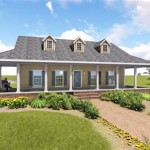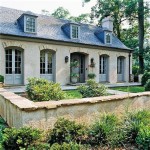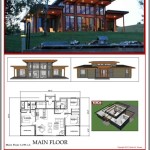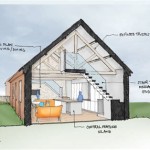House Plans With Porches All the Way Around: A Comprehensive Guide
House plans featuring porches that wrap entirely around the structure offer a unique blend of aesthetic appeal and functional living space. These designs, often referred to as "wrap-around porch homes," evoke feelings of classic American architecture, particularly from the Southern states, and provide homeowners with numerous benefits in terms of outdoor living, ventilation, and curb appeal. This article delves into the specifics of house plans with porches all the way around, exploring their advantages, design considerations, and notable architectural styles.
The fundamental characteristic of these house plans is the continuous porch that envelopes the entire home. This design allows for access to outdoor space from virtually any point inside the house. This connectivity fosters an intimate relationship with the surrounding environment, encouraging outdoor activities and relaxation. The extensive porch area also functions as a natural extension of the interior living space, expanding usable area and providing a comfortable transition between indoors and outdoors.
Advantages of Wrap-Around Porch Homes
Several compelling advantages drive the popularity of house plans featuring wrap-around porches. These benefits extend beyond sheer aesthetics, impacting the comfort, functionality, and value of the home.
Enhanced Outdoor Living Space: The most significant advantage is the provision of ample outdoor living space. A wrap-around porch effectively creates an outdoor room that can be utilized for various activities, including dining, lounging, entertaining guests, or simply relaxing and enjoying the surrounding scenery. The expansive nature of the porch allows for multiple seating areas and configurations, catering to different needs and preferences. Furthermore, the porch provides shelter from the elements, enabling outdoor enjoyment even during light rain or intense sunlight.
Improved Ventilation and Natural Light: A wrap-around porch can significantly improve the natural ventilation of a home. The porch creates shade, reducing direct sunlight exposure and minimizing heat gain within the house. This is particularly beneficial in warmer climates, as it can lower cooling costs and create a more comfortable indoor environment. Additionally, the porch allows for windows and doors to be opened more frequently, promoting natural airflow and further contributing to energy efficiency. Strategic placement of windows and doors in conjunction with the porch design can maximize natural light penetration into the home, reducing the need for artificial lighting during the day.
Increased Curb Appeal and Property Value: House plans with wrap-around porches possess a distinct architectural charm that enhances curb appeal. The visual symmetry and welcoming aesthetic of the continuous porch create a favorable first impression, making the home more attractive to potential buyers. The added outdoor living space also contributes to increased property value. The perceived value is not only based on the square footage of the interior but also on the functional and aesthetic benefits of the exterior spaces. The distinctiveness of the design can also set the home apart from others in the neighborhood, making it a more desirable and sought-after property.
Design Considerations for Wrap-Around Porch Homes
Designing a house with a wrap-around porch requires careful consideration of several factors, including the site orientation, climate, architectural style, and intended use of the porch space. These considerations will influence the overall design and ensure that the porch is both aesthetically pleasing and functionally effective.
Site Orientation and Climate: The orientation of the house on the lot is crucial for maximizing the benefits of the wrap-around porch. In warmer climates, it is beneficial to orient the porch to provide shade during the hottest part of the day. This can be achieved by positioning the house with the porch facing east or west, allowing the roof overhang to block direct sunlight. In cooler climates, consideration should be given to capturing sunlight during the winter months, potentially by incorporating a southern exposure. The prevailing winds should also be considered to ensure that the porch provides adequate protection from strong gusts. In areas prone to heavy rain or snow, the porch roof should be designed with sufficient slope and drainage to prevent water damage.
Porch Width and Depth: The width and depth of the porch are critical factors in determining its usability. A narrow porch may only accommodate a single row of seating, while a wider porch can provide space for multiple seating areas, dining tables, or even outdoor kitchens. The depth of the porch should be sufficient to allow for comfortable movement and furniture placement. A general guideline is to aim for a minimum depth of 8 feet, but larger porches, measuring 10 feet or more in depth, offer greater flexibility and functionality. The porch width contributes to its overall aesthetic impact. A wider porch can create a more substantial and inviting appearance.
Materials and Construction: The materials used for the porch construction should be durable, weather-resistant, and aesthetically consistent with the overall style of the house. Traditional materials such as wood, brick, and stone are commonly used for porch columns, railings, and flooring. Wood decking is a popular choice for porch flooring, offering a warm and natural appearance. However, composite decking materials are also gaining popularity due to their low maintenance requirements and resistance to rot and insect damage. The porch roof can be constructed using a variety of materials, including asphalt shingles, metal roofing, or tile. The choice of roofing material should complement the design of the house and provide adequate protection from the elements.
Architectural Styles Commonly Featuring Wrap-Around Porches
Wrap-around porches are frequently associated with specific architectural styles that emphasize outdoor living and a connection to nature. Several prominent architectural styles often incorporate this design element.
Farmhouse Style: Farmhouse-style homes are characterized by their simple, functional design and emphasis on rustic charm. Wrap-around porches are a common feature of farmhouse-style homes, providing a comfortable and inviting space for relaxing and enjoying the surrounding countryside. The porches are often adorned with rocking chairs, porch swings, and other traditional furnishings. Farmhouse porches often incorporate natural materials such as wood and stone, further enhancing their rustic appeal.
Victorian Style: Victorian homes are known for their elaborate detailing, ornate trim, and asymmetrical designs. Wrap-around porches are frequently incorporated into Victorian-style homes, adding to their grandeur and providing a prominent focal point. Victorian porches often feature intricate spindlework, decorative columns, and elaborate railings. The porches are typically designed to be both functional and aesthetically pleasing, providing a space for entertaining guests and showcasing the home's architectural details.
Craftsman Style: Craftsman-style homes are characterized by their emphasis on handcrafted details, natural materials, and a connection to nature. Wrap-around porches are a common feature of Craftsman-style homes, providing a comfortable and inviting space for outdoor living. Craftsman porches often feature exposed rafters, tapered columns, and natural stone accents. The porches are typically designed to be simple and functional, reflecting the Craftsman aesthetic of understated elegance.
Southern Plantation Style: This architectural style often features grand columns and expansive wrap-around porches. Large roof overhangs are also significant in Southern style houses, offerring lots of shade to the house. The porches are often used for entertaining and social gatherings.
Designing a house plan with a wrap-around porch involves various considerations, from maximizing space and functionality to selecting appropriate materials and architectural styles. The result is a home that blends indoor and outdoor living, offering a unique and appealing living environment. It is a significant undertaking that needs expertise of designers, architects and engineers for the best solution.
:max_bytes(150000):strip_icc()/tideland-haven_0-67e696598afc46328367d3653cfd9724.jpg?strip=all)
13 House Plans With Wrap Around Porches

Southern Living Dreamy House Plans With Front Porches Blog Dreamhomesource Com
Southern Living Dreamy House Plans With Front Porches Blog Dreamhomesource Com

Wrap Around Porch House Plans

Beautiful Small Country House Plans With Porches Houseplans Blog Com

Small House Plans With Porches Why It Makes Sense Bungalow Company

16 Cozy Wraparound Porch Ideas For Homes Of Every Style Front Design

Plan 3027d Wonderful Wrap Around Porch Country House Plans Hill Homes
:max_bytes(150000):strip_icc()/SL-2028_legacy-ranch-6427ec9dfafa4a6aa10a01e65bef0cea.jpg?strip=all)
30 Pretty House Plans With Porches

One Story House Plans With Porches Dfd Blog
Related Posts








